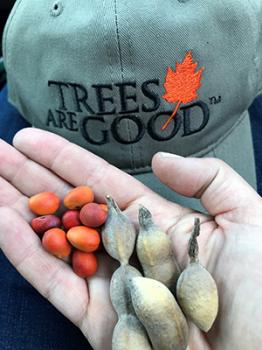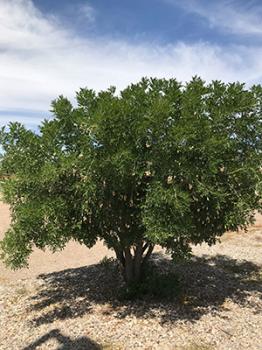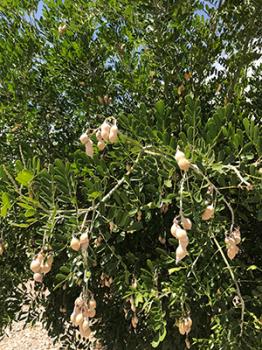November 2, 2019
Texas Mountain Laurel: Small Tree, Big Personality

Question:
We are looking for Texas mountain laurel seeds or saplings. We recently removed some invasive salt cedars that were growing on our property and would like to try Texas mountain laurel as a replacement tree. What can you tell us about these trees and where to find them for sale or as seed?
- Diane C., Tome, NM
Answer:
I’m a big fan of the dense-leaved, evergreen, small-statured, clay-tolerant, heat-loving Texas mountain laurel (Dermatophyllum secundiflorum, previously Sophora secundiflora). They are known to be very slow growers. And while I believe them to be worth the wait (slow and steady wins the race), I don’t expect that they’re particularly useful in restoration projects like yours because the salt cedars will likely grow back much quicker. That being said, they are worth a try.
Nurseries in colder regions may not sell them because they are expected to be cold hardy down to 0-10°F (USDA hardiness zone 7), although some resources list them as being hardy to a slightly warmer zone 8, where average extreme low temperatures only get down to 10-20°F. I purchased one in a 5-gallon pot from a nursery in Las Cruces about 8 years ago for our garden there. I checked on it this week, and although it hasn’t grown much (now approximately 7 ft tall) it has survived on very little water and remains a lush green with dense foliage even after several frosts. I am interested in trying one in a warmer part of my garden here in Los Lunas too.
City of Las Cruces Community Forester, Jimmy Zabriskie, confirmed that they are slow growers (about 3-6 inches of growth per year), but the ones in his garden survived the 2011 freeze quite well, and his temperatures got all the way down to -6°F. At that time the trees had been in the ground about 10 years. Several growers in Albuquerque and Bernalillo warned against planting Texas mountain laurel trees now in those colder areas because they may not make it through the first winter.

Dr. Natalie Goldberg, plant pathologist and interim associate dean/director of the Agricultural Experiment Station, gave me an update on the one she has planted in her front yard in Mesilla. At over 25 years old, it has outlived several cold snaps and stands about 15 feet tall. She says some years it’s loaded with spring blooms, which the bees love, and others it barely blooms at all. (For those who don’t know, the showy purple flowers smell just like grape soda!) Dr. Goldberg removed the two Texas mountain laurel trees in her back yard when she got a new puppy because the foliage and especially the seeds are known to be toxic. When I looked further into their toxicity I found a great resource on a website I’ve been using and recommending for years, the Ladybird Johnson Wildflower Center. The resource that’s new to me is a gardening column called “Ask Mr. Smarty Plants.” When asked about the toxicity of Texas mountain laurel to dogs and livestock, columnist Jimmy Mills replied that the chemical cytisine is found in both the leafy material and seeds, and it is indeed a toxin. Luckily, the foliage is reported to be unpalatable, so it doesn’t pose much of a problem for pets or livestock. And the seed coat is so tough it is possible for the seed to be ingested and passed through the digestive system without incident. However, seeds that have been cracked or scarified do pose a threat, and the pretty red seeds might look enticingly like candy to children.
I checked with nurseries and garden centers in Las Cruces, Albuquerque, and a few in between to see if they keep Texas mountain laurel trees in stock. For details, visit the blog version of Desert Blooms. I also collected some seeds to share with you from trees in Las Cruces—you’ll have to scarify the seeds in order to get them to germinate. Merry Christmas, Diane!

Marisa Y. Thompson, PhD, is the Extension Horticulture Specialist, in the Department of Extension Plant Sciences at the New Mexico State University Los Lunas Agricultural Science Center, email: desertblooms@nmsu.edu, office: 505-865-7340, ext. 113.
Links:
For more gardening information, visit the NMSU Extension Horticulture page at Desert Blooms and the NMSU Horticulture Publications page.
Send gardening questions to Southwest Yard and Garden - Attn: Dr. Marisa Thompson at desertblooms@nmsu.edu, or at the Desert Blooms Facebook page.
Please copy your County Extension Agent and indicate your county of residence when you submit your question!